One more card for today. This one is from an Instagram swap with Lily in Finland, from her adventures in Asia. I LOVED reading about them (and looking at the photos, obviously) on Instagram. Incidentally, Instagram is my favourite social media platform, I'm not too keen on Facebook and rarely post there, and I just don't understand Twitter at all. Anyway. Lily sent me two WOW cards from her holiday. This is my favourite postcard series at the moment, I just love the watercolour illustration, they are so pretty. I'm getting tired of the Greetings from... series, not that I'm able to really get any of the new issues as the countries are all so rare. *sigh* Well, it was fun while it lasted. I'm having problems arranging swaps for cards in this series as well - pretty much everyone already has the UK. At least I manage to arrange the occasional swap, though, and have had friends help.
I was told June is really hot and humid in Thailand. Definitely not a place for me to visit at that time of the year, then! I don't cope very well with hot weather. ...and as I say that, today is the hottest day of the year so far in the UK (possibly EVER, according to the news?!). Over here it's been around +33 C I reckon, which is way too much. I do have this 'cooling towel' I bought on Amazon, but I'm a little disappointed with it. It's basically just a towel that you have to wet, and it cools you down that way. It does work, but it dries in about half an hour or so so I keep having to wet it again and again. As I pointed out on Instagram, I also don't appreciate the comments and the attitude some people have that you shouldn't complain about the heat if you also don't like cold winters either, that 'nothing is good enough'. I'm sorry but I don't cope well with extreme weather, it makes me feel physically unwell. Am I just supposed to pretend that I enjoy this if the hot weather doesn't cause problems to the majority of people?! Not everyone is the same, some people don't tolerate extreme heat or cold well.
Anyway. The above doesn't really have anything to do with this postcard, and that is what I'm supposed to be talking about here, right?! Oooops... The Lantern Festival mentioned on this card sounds really lovely. And Thai food... although I can't eat most of it at the moment because chemotherapy has totally changed my tastebuds - I can't handle spicy/hot foods *at all*, not even the tiniest amount of heat. It's SO annoying, I used to love spicy food and I've got numerous bottles of chilli sauce in the cupboard that I stocked up on earlier last year. Out of the foods mentioned on this postcard, banana pancakes might still be safe for me to eat, I'm not sure of any of the others. And I suppose you can't really leave chillies out of Thai food?! :(
Thursday, 25 July 2019
Archaeological Site of Aigai (modern name Vergina), Greece
Another postcard from Sini in Finland... This wasn't my intention when choosing the cards to post about, but then again, she does send me some of the most amazing postcards so I don't really see a problem. ;) This is from Sini's trip to Greece earlier this year. I wish I could travel even half as much as she does... I'm not even sure when I'll be able to travel abroad again... or how expensive it will be - I've heard it's either really difficult or ridiculously expensive to get travel insurance if you have cancer and are receiving chemotherapy. No fair! :(
The city of Aigai, the ancient first capital of the Kingdom of Macedonia, was discovered in the 19th century near Vergina, in northern Greece. The most important remains are the monumental palace, lavishly decorated with mosaics and painted stuccoes, and the burial ground with more than 300 tumuli, some of which date from the 11th century B.C. One of the royal tombs in the Great Tumulus is identified as that of Philip II, who conquered all the Greek cities, paving the way for his son Alexander and the expansion of the Hellenistic world.
The city of Aigai, the ancient first capital of the Kingdom of Macedonia, was discovered in the 19th century near Vergina, in northern Greece. The most important remains are the monumental palace, lavishly decorated with mosaics and painted stuccoes, and the burial ground with more than 300 tumuli, some of which date from the 11th century B.C. One of the royal tombs in the Great Tumulus is identified as that of Philip II, who conquered all the Greek cities, paving the way for his son Alexander and the expansion of the Hellenistic world.
Bled, Slovenia
Slovenia seems like SUCH a beautiful country, it would be wonderful to get to visit it one day. A Finnish friend of mine, Keiju, got to visit it earlier this summer and treated me to this GLORIOUS postcard (the top one; the second one is from a swap with Europa stamps). Apparently it's always raining at Bled! Just look at these stunning views, though!
Lake Bled is a lake in the Julian Alps of the Upper Carniolan region of northwestern Slovenia, where it adjoins the town of Bled. The area is a tourist destination. The lake is 35 km from Ljubljana International Airport and 55 km from the capital city, Ljubljana. The lake is of mixed glacial and tectonic origin. It is 2,120 m long and 1,380 m wide, with a maximum depth of 29.5 m, and it has a small island. The lake lies in a picturesque environment, surrounded by mountains and forests. Medieval Bled Castle stands above the lake on the north shore and has a museum. The Zaka Valley lies at the west end of the lake. The World Rowing Championships in 1966, 1979, 1989, and 2011 were held at Lake Bled.
The lake surrounds Bled Island (Blejski otok). The island has several buildings, the main one being the pilgrimage church dedicated to the Assumption of Mary (Cerkev Marijinega vnebovzetja), built in its current form near the end of the 17th century, and decorated with remains of Gothic frescos from around 1470 in the presbyterium and rich Baroque equipment. The church has a 52 m tower and there is a Baroque stairway dating from 1655 with 99 stone steps leading up to the building. The church is frequently visited and weddings are held there regularly. Traditionally it is considered good luck for the groom to carry his bride up the steps on the day of their wedding before ringing the bell and making a wish inside the church.
^The stamp on Keiju's card. We were both wondering if this is a real stamp as the image is so blurry?!?
^...and the stamps on the second card. How beautiful are they?! Once again I'm annoyed at the Royal Mail for not issuing a Europa stamp this year. Why, WHY are they not interested in participating??
Lake Bled is a lake in the Julian Alps of the Upper Carniolan region of northwestern Slovenia, where it adjoins the town of Bled. The area is a tourist destination. The lake is 35 km from Ljubljana International Airport and 55 km from the capital city, Ljubljana. The lake is of mixed glacial and tectonic origin. It is 2,120 m long and 1,380 m wide, with a maximum depth of 29.5 m, and it has a small island. The lake lies in a picturesque environment, surrounded by mountains and forests. Medieval Bled Castle stands above the lake on the north shore and has a museum. The Zaka Valley lies at the west end of the lake. The World Rowing Championships in 1966, 1979, 1989, and 2011 were held at Lake Bled.
The lake surrounds Bled Island (Blejski otok). The island has several buildings, the main one being the pilgrimage church dedicated to the Assumption of Mary (Cerkev Marijinega vnebovzetja), built in its current form near the end of the 17th century, and decorated with remains of Gothic frescos from around 1470 in the presbyterium and rich Baroque equipment. The church has a 52 m tower and there is a Baroque stairway dating from 1655 with 99 stone steps leading up to the building. The church is frequently visited and weddings are held there regularly. Traditionally it is considered good luck for the groom to carry his bride up the steps on the day of their wedding before ringing the bell and making a wish inside the church.
^The stamp on Keiju's card. We were both wondering if this is a real stamp as the image is so blurry?!?
^...and the stamps on the second card. How beautiful are they?! Once again I'm annoyed at the Royal Mail for not issuing a Europa stamp this year. Why, WHY are they not interested in participating??
Stockholm, Sweden
Another holiday postcard here, this time from the lovely Ana. She has been to so many awesome places! I think I've only been to Stockholm once, I would really love to go there again some time!
Stockholm is the capital of Sweden and the most populous urban area in the Nordic countries; 965,232 people live in the municipality, approximately 1.6 million in the urban area, and 2.4 million in the metropolitan area. The city stretches across fourteen islands where Lake Mälaren flows into the Baltic Sea. Outside the city to the east, and along the coast, is the island chain of the Stockholm archipelago. The area has been settled since the Stone Age, in the 6th millennium BC, and was founded as a city in 1252 by Swedish statesman Birger Jarl. It is also the county seat of Stockholm County.
Stockholm is the cultural, media, political, and economic centre of Sweden. The Stockholm region alone accounts for over a third of the country's GDP, and is among the top 10 regions in Europe by GDP per capita. It is an important global city, and the main centre for corporate headquarters in the Nordic region. The city is home to some of Europe's top ranking universities, such as the Stockholm School of Economics, Karolinska Institute and Royal Institute of Technology (KTH). It hosts the annual Nobel Prize ceremonies and banquet at the Stockholm Concert Hall and Stockholm City Hall. One of the city's most prized museums, the Vasa Museum, is the most visited non-art museum in Scandinavia. The Stockholm metro, opened in 1950, is well known for the decor of its stations; it has been called the longest art gallery in the world. Sweden's national football arena is located north of the city centre, in Solna. Ericsson Globe, the national indoor arena, is in the southern part of the city. The city was the host of the 1912 Summer Olympics, and hosted the equestrian portion of the 1956 Summer Olympics otherwise held in Melbourne, Victoria, Australia.
Stockholm is the seat of the Swedish government and most of its agencies, including the highest courts in the judiciary, and the official residencies of the Swedish monarch and the Prime Minister. The government has its seat in the Rosenbad building, the Riksdag (Swedish parliament) is seated in the Parliament House, and the Prime Minister's residence is adjacent at Sager House. Stockholm Palace is the official residence and principal workplace of the Swedish monarch, while Drottningholm Palace, a World Heritage Site on the outskirts of Stockholm, serves as the Royal Family's private residence.
Stockholm is the capital of Sweden and the most populous urban area in the Nordic countries; 965,232 people live in the municipality, approximately 1.6 million in the urban area, and 2.4 million in the metropolitan area. The city stretches across fourteen islands where Lake Mälaren flows into the Baltic Sea. Outside the city to the east, and along the coast, is the island chain of the Stockholm archipelago. The area has been settled since the Stone Age, in the 6th millennium BC, and was founded as a city in 1252 by Swedish statesman Birger Jarl. It is also the county seat of Stockholm County.
Stockholm is the cultural, media, political, and economic centre of Sweden. The Stockholm region alone accounts for over a third of the country's GDP, and is among the top 10 regions in Europe by GDP per capita. It is an important global city, and the main centre for corporate headquarters in the Nordic region. The city is home to some of Europe's top ranking universities, such as the Stockholm School of Economics, Karolinska Institute and Royal Institute of Technology (KTH). It hosts the annual Nobel Prize ceremonies and banquet at the Stockholm Concert Hall and Stockholm City Hall. One of the city's most prized museums, the Vasa Museum, is the most visited non-art museum in Scandinavia. The Stockholm metro, opened in 1950, is well known for the decor of its stations; it has been called the longest art gallery in the world. Sweden's national football arena is located north of the city centre, in Solna. Ericsson Globe, the national indoor arena, is in the southern part of the city. The city was the host of the 1912 Summer Olympics, and hosted the equestrian portion of the 1956 Summer Olympics otherwise held in Melbourne, Victoria, Australia.
Stockholm is the seat of the Swedish government and most of its agencies, including the highest courts in the judiciary, and the official residencies of the Swedish monarch and the Prime Minister. The government has its seat in the Rosenbad building, the Riksdag (Swedish parliament) is seated in the Parliament House, and the Prime Minister's residence is adjacent at Sager House. Stockholm Palace is the official residence and principal workplace of the Swedish monarch, while Drottningholm Palace, a World Heritage Site on the outskirts of Stockholm, serves as the Royal Family's private residence.
Helsinki, Finland
This is one of the two non-holiday cards for today. Although... it's from a meet-up that Addis from Puerto Rico attended when she was on holiday in Finland, so technically this could be a holiday card as well...?! :D I received this from Sini, though, she keeps spoiling me with wonderful postcards, often from her travels.
I remember seeing a picture of this postcard on Instagram and thinking how awesome it is, wishing I would receive one as well but very much doubting the possibility. I was so pleased to be wrong! :) I just really, really like the picture. It reminds me of my childhood - I used to go to places like this wih my mum to wash carpets. I can't remember if they were run by the local council, they very well could have been and I think they still exist. I'm not sure how environmentally friendly they are, though, when all the washing liquids etc end up in the lake/sea. The picture used on this card was taken in the 1950's.
I remember seeing a picture of this postcard on Instagram and thinking how awesome it is, wishing I would receive one as well but very much doubting the possibility. I was so pleased to be wrong! :) I just really, really like the picture. It reminds me of my childhood - I used to go to places like this wih my mum to wash carpets. I can't remember if they were run by the local council, they very well could have been and I think they still exist. I'm not sure how environmentally friendly they are, though, when all the washing liquids etc end up in the lake/sea. The picture used on this card was taken in the 1950's.
Alghero, Sardinia, Italy
Ooops... It's been almost a year since I last posted here! That certainly wasn't my intention. Things have happened during this time, though, and my life has been pretty much turned upside down. In October last year I was diagnosed with bowel cancer that had also spread to my liver and lungs. Not something I would have expected as a 36-year old! I had rather an evently 6-week hospital stay, and have been having chemotherapy since. (My next session is tomorrow.) Needless to say postcards got neglected for a while after the diagnosis, but I got back to swapping and collecting postcards fairly quickly again as it's one of the things that keep me at least somewhat sane and brings me joy. I'm trying to remain positive, and postcards have definitely helped with that!
There's a theme for today's cards - apart from a couple, they were all sent by friends or other Postcrossers from their holidays. It has been really interesting to hear more about their trips, and while I'm not able to travel anywhere outside of the UK at the moment (or even too far in the UK), this still brings me into holiday mood. :)
Today's first card is from my friends Keith and Jackie. They were on holiday in Sardinia earlier this summer. I asked them if they could send me a postcard, and they did! This might be my first postcard from Sardinia as well, I'm not quite sure. Hmmm...
Alghero, also known in the local Algherese dialect as L'Alguer, is a town of about 45,000 inhabitants in the Italian insular province of Sassari in northwestern Sardinia, next to the Mediterranean Sea. Part of its population descends from Catalan conquerors from the end of the Middle Ages, when Sardinia was part of the Crown of Aragon. Hence, the Catalan language is co-official (a unique situation in Italy) and known as the Alguerès dialect. The name Alghero comes from Aleguerium, which is a mediaeval Latin word meaning "stagnation of algae" (Posidonia oceanica).
Alghero is the third university center in the island, coming after Cagliari and Sassari. It hosts the headquarters of the Università degli Studi di Sassari’s Architecture and Design department. In 2012 it was the 10th most visited city by tourists in Italy.
Sardinia is the second-largest island in the Mediterranean Sea (after Sicily and before Cyprus). It is located west of the Italian Peninsula and to the immediate south of the French island of Corsica.
Sardinia is politically a region of Italy, whose official name is Regione Autonoma della Sardegna / Regione Autònoma de Sardigna (Autonomous Region of Sardinia), and enjoys some degree of domestic autonomy granted by a specific Statute. It is divided into four provinces and a metropolitan city, with Cagliari being the region's capital and also its largest city. Sardinia's indigenous language and the other minority languages (Sassarese, Corsican Gallurese, Algherese Catalan and Ligurian Tabarchino) spoken on the island are recognized by the regional law and enjoy "equal dignity" with Italian.
Due to the variety of its ecosystems, which include mountains, woods, plains, largely uninhabited territories, streams, rocky coasts and long sandy beaches, the island has been defined metaphorically as a micro-continent. In the modern era, many travelers and writers have extolled the beauty of its untouched landscape, which houses the vestiges of the Nuragic civilization.
I don't normally comment on stamps here, but this one is just weird! Anyone got any information on this? It reminds me of the stamps I once bought in Spain... Why does the cancellation say 'San Marino'?? Strange!
There's a theme for today's cards - apart from a couple, they were all sent by friends or other Postcrossers from their holidays. It has been really interesting to hear more about their trips, and while I'm not able to travel anywhere outside of the UK at the moment (or even too far in the UK), this still brings me into holiday mood. :)
Today's first card is from my friends Keith and Jackie. They were on holiday in Sardinia earlier this summer. I asked them if they could send me a postcard, and they did! This might be my first postcard from Sardinia as well, I'm not quite sure. Hmmm...
Alghero, also known in the local Algherese dialect as L'Alguer, is a town of about 45,000 inhabitants in the Italian insular province of Sassari in northwestern Sardinia, next to the Mediterranean Sea. Part of its population descends from Catalan conquerors from the end of the Middle Ages, when Sardinia was part of the Crown of Aragon. Hence, the Catalan language is co-official (a unique situation in Italy) and known as the Alguerès dialect. The name Alghero comes from Aleguerium, which is a mediaeval Latin word meaning "stagnation of algae" (Posidonia oceanica).
Alghero is the third university center in the island, coming after Cagliari and Sassari. It hosts the headquarters of the Università degli Studi di Sassari’s Architecture and Design department. In 2012 it was the 10th most visited city by tourists in Italy.
Sardinia is the second-largest island in the Mediterranean Sea (after Sicily and before Cyprus). It is located west of the Italian Peninsula and to the immediate south of the French island of Corsica.
Sardinia is politically a region of Italy, whose official name is Regione Autonoma della Sardegna / Regione Autònoma de Sardigna (Autonomous Region of Sardinia), and enjoys some degree of domestic autonomy granted by a specific Statute. It is divided into four provinces and a metropolitan city, with Cagliari being the region's capital and also its largest city. Sardinia's indigenous language and the other minority languages (Sassarese, Corsican Gallurese, Algherese Catalan and Ligurian Tabarchino) spoken on the island are recognized by the regional law and enjoy "equal dignity" with Italian.
Due to the variety of its ecosystems, which include mountains, woods, plains, largely uninhabited territories, streams, rocky coasts and long sandy beaches, the island has been defined metaphorically as a micro-continent. In the modern era, many travelers and writers have extolled the beauty of its untouched landscape, which houses the vestiges of the Nuragic civilization.
I don't normally comment on stamps here, but this one is just weird! Anyone got any information on this? It reminds me of the stamps I once bought in Spain... Why does the cancellation say 'San Marino'?? Strange!
Sunday, 26 August 2018
Maribor, Slovenia
Just one more card for today. This one is from dear Ana from her holidays in December last year. Maribor certainly looks lovely and cosy! I'm looking forward to sending some holiday cards in October as well. :) I also have two days holiday next month - my sister is coming to London so I'll go see her (I just need to book train or coach tickets and accommodation now...). I don't think I'll send any postcards from London though. :P I'm more looking forward to meeting my sister again as I haven't seen her for quite a while.
Maribor is the second-largest city in Slovenia and the largest city of the traditional region of Lower Styria. It is also the seat of the City Municipality of Maribor.
Maribor is the second-largest city in Slovenia and the largest city of the traditional region of Lower Styria. It is also the seat of the City Municipality of Maribor.
Guernsey
I've been trying to post more recent cards (i.e. received either this year or last year) today so here is another one from this summer. This is from the 'I'm going on Vacation RR' on the Postcrossing forum, I've actually been able to get into a few groups recently. This is still one of my only written & stamped postcards from Guernsey.
The views sure look gorgeous here! Top left corner is 'Petit Port', next to it is 'Moulin Huet'. Bottom left shows 'Icart View' and the fourth picture shows 'Fermain'. I would rather like to visit Guernsey some time but I've heard it's really expensive and I'm not sure how there would be to do...
I'm so happy to receive another Europa stamp. It has been difficult to collect them again this year because once again the Royal Mail haven't bothered to issue one. ...and there are plenty of great bridges in the UK! It seems they just don't care about Europa stamps anymore. :(
The views sure look gorgeous here! Top left corner is 'Petit Port', next to it is 'Moulin Huet'. Bottom left shows 'Icart View' and the fourth picture shows 'Fermain'. I would rather like to visit Guernsey some time but I've heard it's really expensive and I'm not sure how there would be to do...
I'm so happy to receive another Europa stamp. It has been difficult to collect them again this year because once again the Royal Mail haven't bothered to issue one. ...and there are plenty of great bridges in the UK! It seems they just don't care about Europa stamps anymore. :(
Greetings from Kyrgyzstan
I'm starting to lose interest with this series a bit... the cards all seem so alike no and it seems like there's not much effort put into them, although that could just be me... although it does depress me that a lot of senders can't be bothered to write anything other than 'greetings from x country' on their card.
I don't even know what else to write about this card... apart from the fact that I bet there aren't 80 ACTIVE Postcrossing members in Kyrgyzstan, something that has always frustrated me about this series.
I don't even know what else to write about this card... apart from the fact that I bet there aren't 80 ACTIVE Postcrossing members in Kyrgyzstan, something that has always frustrated me about this series.
Engelsberg Ironworks, Sweden
Not moving very far with this card... This is from a swap with Doris in Sweden earlier this month.
Ecomuseum Bergslagen (Swedish: Ekomuseum Bergslagen) is an open-air museum in the western part of the former mining and smelting region of Bergslagen in central Sweden. The museum opened in 1986 and is today the world's largest ecomuseum. The museum is a joint project of the municipalities Ludvika, Smedjebacken, Fagersta, Norberg, Skinnskatteberg, Surahammar and Hallstahammar. Two provincial museums in Dalarna and Västmanland County participate in the project. Ecomuseum Bergslagen is a 750 square kilometre area reaching from Lake Mälaren in the south to Forest Finns forests in the north. It takes about three hours by car to travel from north to south and the visitors travel on their own through the landscape. About 60 sites describe how human beings have used the region's natural resources to survive over time. The history of production of iron is the theme of the museum. Bergslagen was once the most important iron area in Sweden.
You can follow the history of mining for more than 2000 years – from 400 BC until today. Ekomuseum Bergslagen shows mythical pre-historic ironwork sites with historical blast furnacees and smithy, rolling mills, and modern steel businesses along the vital transportation route, the Strömsholms Canal. But also castles, such as Strömsholm Palace, workers' homes in Ludvika and Grängesberg and Forest Finns simple settlements and cottages near Grangärde. The museum includes several mining areas, local museums, electric power stations, historical railways (Engelsberg-Norberg Railway), and a historical railway museum (Railway museum Grängesberg). One of the attractions is Lapphyttan in Norberg Municipality, may be regarded as the type site for the Medieval Blast Furnace. Its date is probably between 1150 and 1350. It produced cast iron, which was then fined to make ferritic wrought iron cake or bun-like blooms. Another attraction is Engelsberg Ironworks (Swedish: Engelsbergs bruk), an ironworks in Ängelsberg. It was built in 1681 and is listed as a UNESCO world heritage site since 1993.
Ecomuseum Bergslagen (Swedish: Ekomuseum Bergslagen) is an open-air museum in the western part of the former mining and smelting region of Bergslagen in central Sweden. The museum opened in 1986 and is today the world's largest ecomuseum. The museum is a joint project of the municipalities Ludvika, Smedjebacken, Fagersta, Norberg, Skinnskatteberg, Surahammar and Hallstahammar. Two provincial museums in Dalarna and Västmanland County participate in the project. Ecomuseum Bergslagen is a 750 square kilometre area reaching from Lake Mälaren in the south to Forest Finns forests in the north. It takes about three hours by car to travel from north to south and the visitors travel on their own through the landscape. About 60 sites describe how human beings have used the region's natural resources to survive over time. The history of production of iron is the theme of the museum. Bergslagen was once the most important iron area in Sweden.
You can follow the history of mining for more than 2000 years – from 400 BC until today. Ekomuseum Bergslagen shows mythical pre-historic ironwork sites with historical blast furnacees and smithy, rolling mills, and modern steel businesses along the vital transportation route, the Strömsholms Canal. But also castles, such as Strömsholm Palace, workers' homes in Ludvika and Grängesberg and Forest Finns simple settlements and cottages near Grangärde. The museum includes several mining areas, local museums, electric power stations, historical railways (Engelsberg-Norberg Railway), and a historical railway museum (Railway museum Grängesberg). One of the attractions is Lapphyttan in Norberg Municipality, may be regarded as the type site for the Medieval Blast Furnace. Its date is probably between 1150 and 1350. It produced cast iron, which was then fined to make ferritic wrought iron cake or bun-like blooms. Another attraction is Engelsberg Ironworks (Swedish: Engelsbergs bruk), an ironworks in Ängelsberg. It was built in 1681 and is listed as a UNESCO world heritage site since 1993.
What do you know about Finland
Continuing on with the 'summer postcard pal' theme... I've been doing it for years but it hasn't seemed so popular this year. I was only able to find one postcard pal for this summer which is a shame, although the cards from Henriikka have been real treats so I could say it's also quality over quantity.. ;) She helped send back this card from Finland - I've started collecting this series but it has been difficult to arrange swaps. ....and I think this series is so much prettier than, say, 'World Travel', and even 'Greetings from' cards now all seem to look the same... :/
I rather like the fact that Finland has more heavy metal bands per capita than any other country in the world. It has always seemed pretty obvious to me, and most local bands in my old hometown, Lappeenranta, seemed to be metal bands when I was young and I think they still are. Henriikka told me that a while back there was a competition to find the 'heavy metal capital' of Finland, and that Lemi, a small municipality next to Lappeenranta, won. Yay!
This set of food stamps was issued earlier this year. I think they are awesome, there's also rye bread, salmiakki... and this one with 'bread cheese'. It's gorgeous and one of the things I miss from Finland. ..cloudberries, also seen on this stamp, are also very tasty.
I rather like the fact that Finland has more heavy metal bands per capita than any other country in the world. It has always seemed pretty obvious to me, and most local bands in my old hometown, Lappeenranta, seemed to be metal bands when I was young and I think they still are. Henriikka told me that a while back there was a competition to find the 'heavy metal capital' of Finland, and that Lemi, a small municipality next to Lappeenranta, won. Yay!
This set of food stamps was issued earlier this year. I think they are awesome, there's also rye bread, salmiakki... and this one with 'bread cheese'. It's gorgeous and one of the things I miss from Finland. ..cloudberries, also seen on this stamp, are also very tasty.
Nordkalotten, Lapland
It has cooled down SO much since I last wrote here.. The heatwave is definitely over, it's not fairly chilly and raining and I've actually had to turn our little heater on because I was so cold. I'm still glad it's not so ridiculously hot anymore as the heat was making me ill... Not that I've been feeling too well recently but that's another story.. :P
Anyway... I've been meaning to post about this card for a while, I received it last year from 'Tua' in Finland. She was one of my 'summer postcard pals' last summer and I really enjoyed receiving cards from her, they were something different as she lives quite far north in the Finnish Lapland. You can't tell it from here but this card is HUGE so you can actually read the place names and see the little pictures. :)
The Cap of the North (Nordkalotten in Norwegian and Swedish, or Pohjoiskalotti in Finnish) consists of the counties Finnmark, Nordland and Troms in Norway, Norrbotten County in Sweden, Lapland/Lappi Region in Finland and Murmansk Oblast in Russia.
This area is roughly equal to the parts of Fennoscandia (including the Kola Peninsula in Russia) lying north of the Arctic Circle. The region has a subarctic climate and is home to the majority of the Sámi people.
Anyway... I've been meaning to post about this card for a while, I received it last year from 'Tua' in Finland. She was one of my 'summer postcard pals' last summer and I really enjoyed receiving cards from her, they were something different as she lives quite far north in the Finnish Lapland. You can't tell it from here but this card is HUGE so you can actually read the place names and see the little pictures. :)
The Cap of the North (Nordkalotten in Norwegian and Swedish, or Pohjoiskalotti in Finnish) consists of the counties Finnmark, Nordland and Troms in Norway, Norrbotten County in Sweden, Lapland/Lappi Region in Finland and Murmansk Oblast in Russia.
This area is roughly equal to the parts of Fennoscandia (including the Kola Peninsula in Russia) lying north of the Arctic Circle. The region has a subarctic climate and is home to the majority of the Sámi people.
Subscribe to:
Posts (Atom)





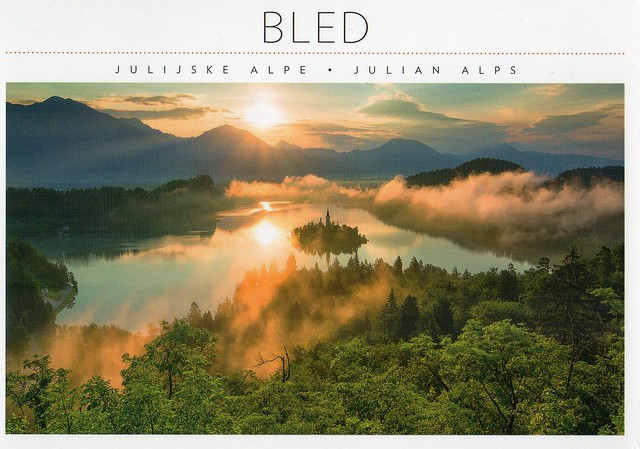




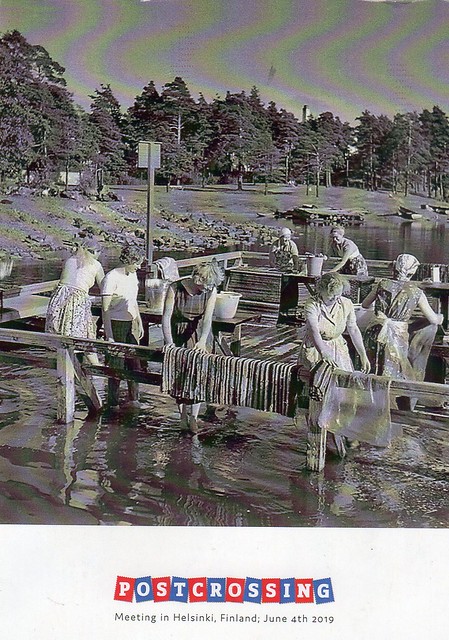

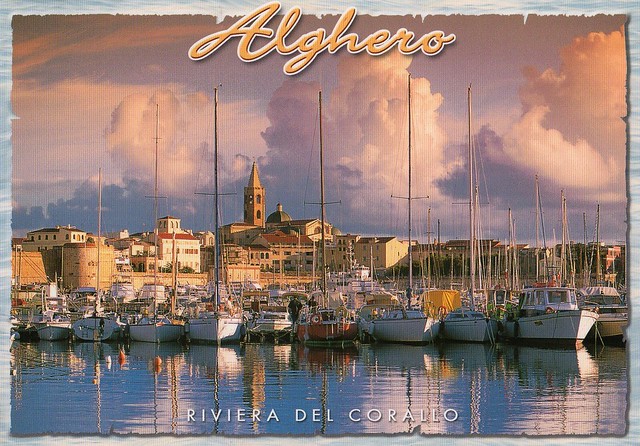

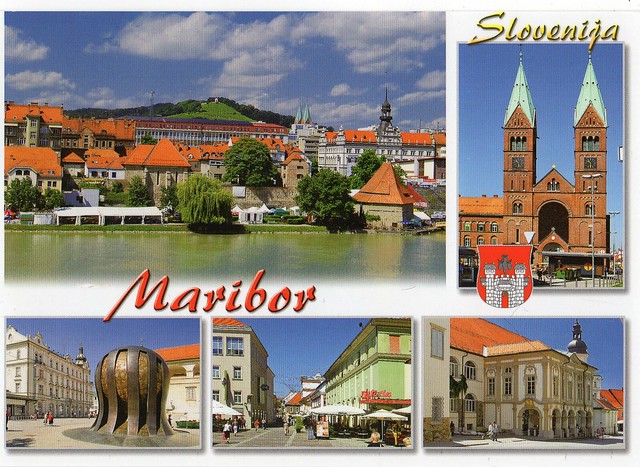

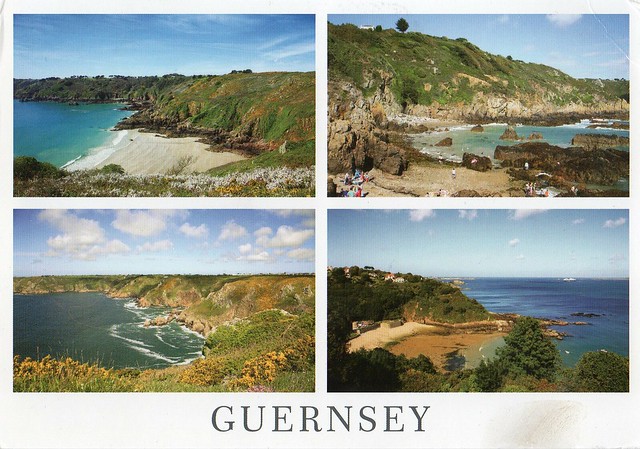

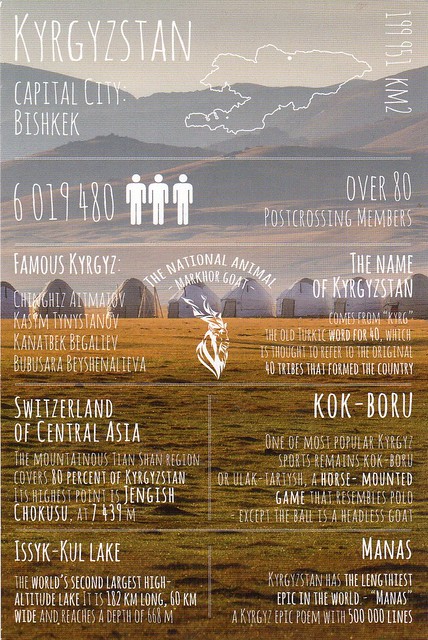

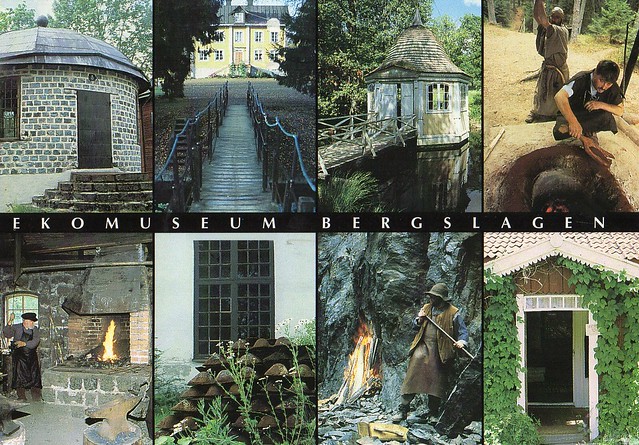

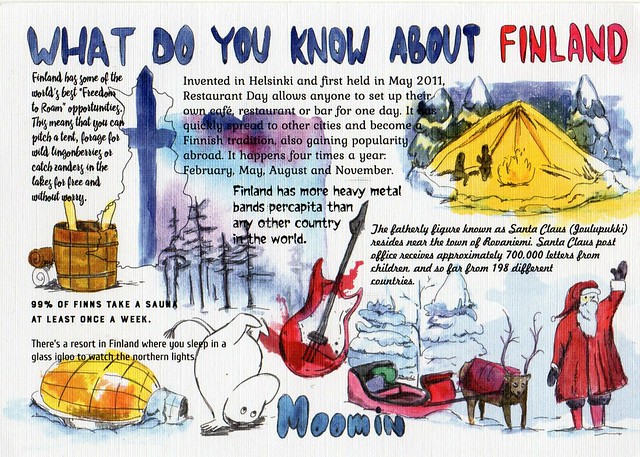

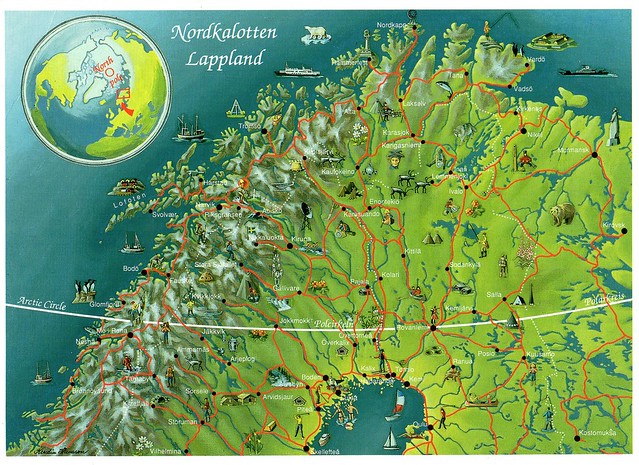



 Maroon
Maroon 









































































































































































